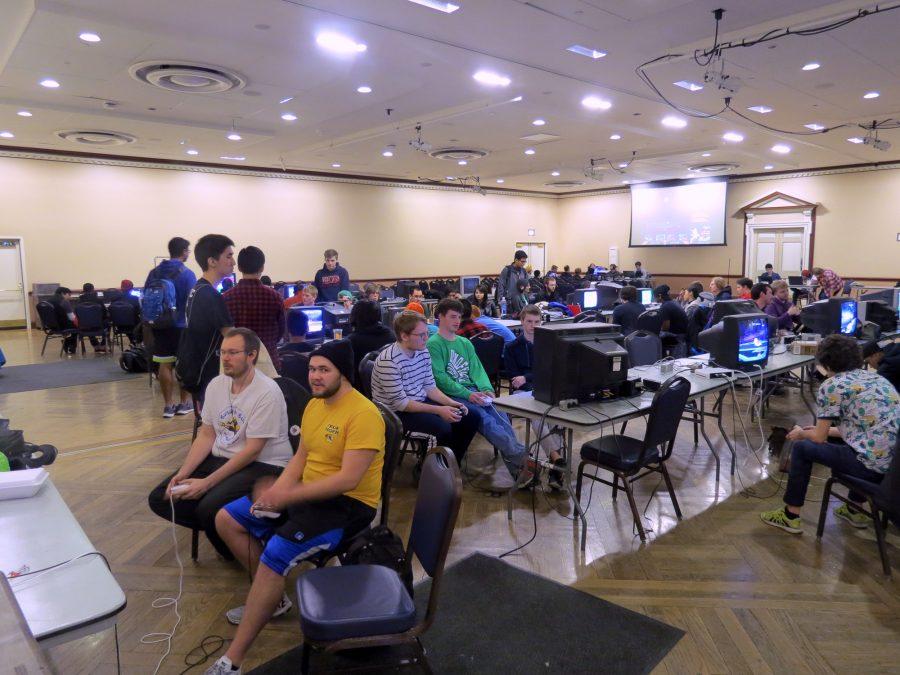Super Smash Bros. Melee: A beautiful accident
Students play against each other in Super Smash Bros. Melee at the Illini Union during the spring 2016 semester.
Oct 5, 2016

If you had a childhood, then you probably already know — everybody has played the “Super Smash Bros.” series at least once in their lives.
The series is a quintessential party game for millennials because of its strong appeal to our childhood heroes. It’s a series that unites people because most everyone knows Nintendo. Whether you were a Mario fanboy, a Pokémon trainer or had an affinity for being an elf in white tights, “Super Smash Bros.” had a character for everybody.
But there’s one game that stands out: “Super Smash Bros. Melee.” Released in 2001, it has sold over 7 million copies worldwide, making it the GameCube’s best-selling game. The successor to the original, Melee is regarded as the most successful fighting game ever; it has a competitive lifespan of over 15 years, and it has outlived all other fighting games that were released around 2001.
Of course, Melee didn’t always have a competitive scene; it was originally intended to be a party game. Along with “Mario Party” and “Mario Kart,” the game was meant to be a casual time-killer at your best friend’s birthday party.
Get The Daily Illini in your inbox!
Competitively, the game had humble beginnings. Competitive Melee began as a grassroots community; what started off as local meetups in people’s basements exploded to national tournaments across the country with thousands of people attending.
The game’s competitive aspect was the main factor in drawing people together. Players would devote thousands of hours perfecting their skills in the game to become the best. People would volunteer to commentate and organize a multitude of events to draw in newcomers. Everyone had a role in something, even if they didn’t know it. That’s partly the reason why the game is still growing today.
Competitive Melee has spread to thousands of colleges and universities across the country, including our very own community on campus: the Smashing Illini. Weeklies are held every Friday at the Union, and members are always hosting throughout the week for those who want some extra practice. Players and organizers are welcoming and extremely dedicated to expanding the scene, making it a home away from home for many, including myself.
It’s not all just Melee, either. With the release of “Super Smash Bros for Wii U,” the community has expanded to a much wider audience. The game provides a much more casual feel, which makes it easier to get into. But that doesn’t mean you can’t get competitive with it, either. Weeklies are held every Wednesday at the Union with the same hospitality as those who play Melee.
In fact, the longest running Smash tournament series happens to be right here on campus. Show Me Your Moves had its 17th tournament earlier this September. Hosting Smash 64, Melee and Smash 4, the event had over 300 entrants combined. Several top players across the midwest — and even one from the UK — showed up to compete for the $1000 pot bonus for their respective events.
Having entered this tournament, I can proudly say that I got destroyed. But the experience, the hype and the opportunity to see top players duking it out right in front of me? Absolutely worth it.
These tournaments get much, much bigger than this. The largest tournament series in the midwest, The Big House 6, is this weekend. Over 2,700 entrants are coming from all over the world to compete during this three-day tournament.
This past summer marked the 15th year of the Evolution Championship Series, known for being the largest and most prestigious fighting game tournament ever. With over $20,000 in prize payout for both Smash 4 and Melee, and a peak viewership of 232,000 on Twitch, there’s no doubt that Smash is kind of a big deal.
Nintendo didn’t have plans for the game to develop into a skill-intensive, fast paced fighter that draws spectators across the globe. But this exposure has even branched out to sponsorships, with companies like Red Bull and HTC joining in on the scene.
As of right now, The Smashing Illini RSO has about 1,200 members, and the number is only going up.
You don’t have know a single thing about Smash to come to these. While the tournaments can get extremely competitive, often times coming down to the smallest of mistakes, there are always people willing to play friendly matches — myself included. But the competitiveness of Smash is what keeps it interesting, for both players and spectators.
There’s just something about watching video game characters beating each other to a pulp that makes it so enjoyable.
Tyler is a freshman in Media.






